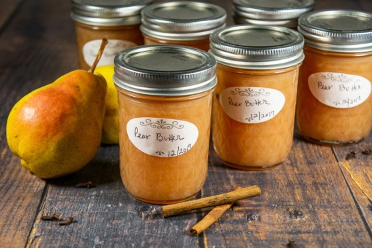What is your favorite spread to go along with peanut butter. Typically we choose a jelly or a jam or marmalade or some fruit topping made with fruit, sugar and pectin. We have many recipes for many different fruits and fruit combinations for our jellies and jams. But have you ever tried a fruit butter? Since we are all hunkered down and have time on our hands here is a new challenge for you, try making a fruit butter with your favorite fruit. Apples are readily available, but Jim and Sue Farr have given us a recipe and a resource to make butters other than peanut or apple. Try this after you go to your favorite Farmers Market and get a supply of your favorite fruit. Enjoy!
Fruit Butters: More Than Just Apple
When I was growing up when we ran out of Welch's grape jelly for our breakfast toast, next in line was a jar of my mother's homemade apple butter. Besides apple butter which was a staple in many homes in the 50s and 60s, there are now recipes for making a variety of fruit butters beyond apple.
Fruit butters, as their name implies, are smooth, creamy spreads. They are made by slowly cooking fruit pulp and sugar to a thick but spreadable consistency. Spices or a second fruit are often added to enhance the flavor. Fruit butters are often made with less sugar than jams and have less of a candied fruit flavor. They are also simpler in that they do not contain any added pectin.
Among their many uses, those soft spreads make an excellent filling for layer cakes and the basis for a delicious trifle. Just spread the fruit butter of your choice on sliced pound cake, then layer with fresh fruit, vanilla pudding and, if desired, whipped cream. They also make an excellent filling for sandwich cookies. Simply spread butter on a plain cookie and top with a second cookie. Fruit butters can also be substituted for some of the fat in many baking recipes to produce delicious baked goods that are lower in fat. Fruit butters make excellent gifts.
Tips on Cooking Butters
Butters are cooked over medium to medium-high heat. To prevent scorching, stir butters frequently, especially as they thicken and reach the doneness point. Cooking times will vary depending on the diameter of the saucepan, the type of fruit and the intensity of the heat. Most butters will need 30 to 60 minutes of cooking time. Butters cook best in a wide diameter, heavy bottomed stainless steel saucepan. The extended cooking time evaporates moisture, thickening the fruit mixture and creating a spreadable, buttery texture.
Tips on Testing Fruit Butters for Doneness
Butters are cooked until they thicken and begin to hold their shape on a spoon. To assess doneness, spoon a small quantity of cooked mixture onto a chilled plate. When liquid does not separate, creating a rim around the edge, and the mixture holds a buttery, spreadable shape, the butter is ready to ladle into jars and process.
Below is a typical example of a fruit butter recipe (Reference: Ball Complete Book of Home Preserving – publication date 2015, page 57). For any given recipe there are also variations often included in the recipes depending on uses for the butter and personal tastes.
The recipe for Peach Butter
Peach butter: makes eight 8 ounce jars or four 16 ounce (pint) jars
4 ½ lbs Peaches, peeled, pitted and coarsely chopped
½ cup Water
4 cups Granulated sugar
Grated zest and juice of one (1) lemon
- In a large stainless steel saucepan, combine peaches, water and lemon zest and juice. Bring to a boil over medium-high heat. Reduce heat and boil gently, stirring occasionally, until peaches are soft, about 20 minutes.
- Working in batches, transfer peach mixture to a food mill or a food processor fitted with a metal blade and puree just until uniform texture is achieved. Do not liquefy. Measure 8 cups of peach puree.
- In a clean large stainless steel saucepan, combine peach puree and sugar. Stir until sugar dissolves. Bring to a boil over medium-high heat, stirring frequently. Reduce heat and boil gently, stirring frequently, until mixture thickens and holds its shape on a spoon.
- Meanwhile, prepare canner, jars and lids
- Ladle hot butter into hot jars, leaving ¼ inch headspace. Remove air bubbles and adjust headspace, if necessary, by adding hot butter. Wipe rim. Center lid on jar. Screw band down until resistance is met, then increase to fingertip-tight.
- Place jars in canner ensuring they are completely covered with water. Bring to a boil and process for 10 minutes. Remove canner lid. Wait 5 minutes, then remove jars, cool and store.
Variations:
For a more sophisticated fruit butter, reduce the sugar to 3 cups. When butter has begun to thicken but does not quite mound on a spoon, add 1 cup of your favorite spirit, such as amaretto liqueur or a sweet wine, and continue cooking, stirring frequently, until mixture mounds on a spoon.
Another variation is to replace peaches in the above recipe with pears. The 41/2 lbs of peaches is replaced with 7 lbs pears, peeled, cored and coarsely chopped. The rest of the recipe is same as the peach recipe above with the exception that grated orange zest and juice as well as nutmeg (1 tsp) may be added.
There are other fruit butter recipes using for example: crabapples, apricots, yellow tomatoes, prunes and blueberries.
These and other recipes can be found in Ball Canning Books.